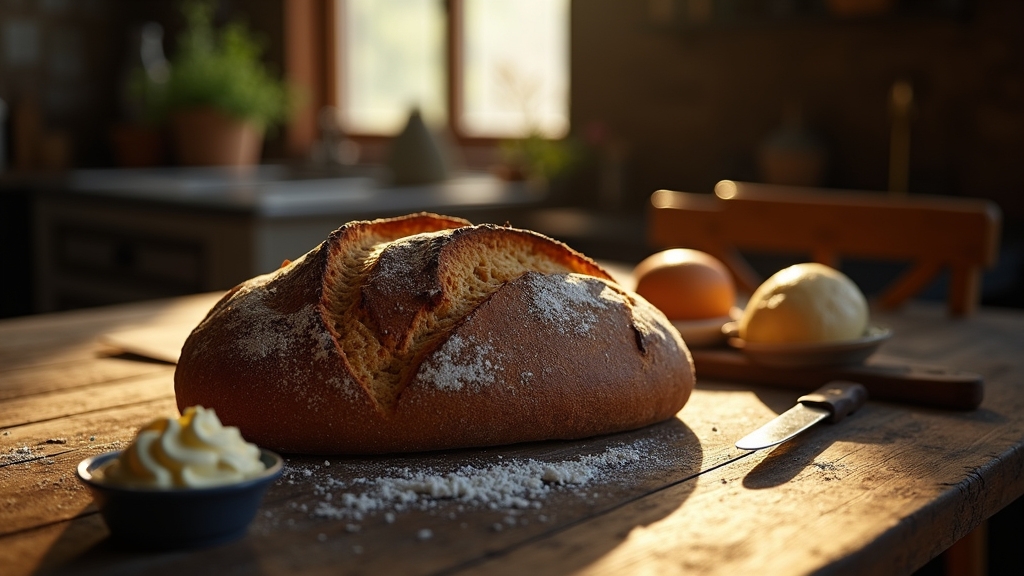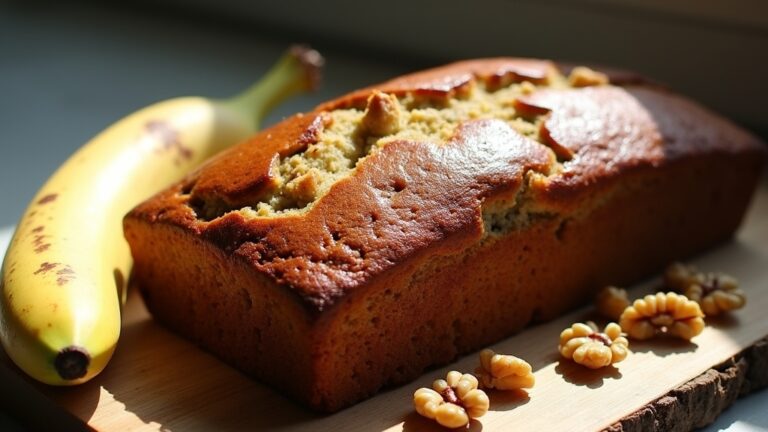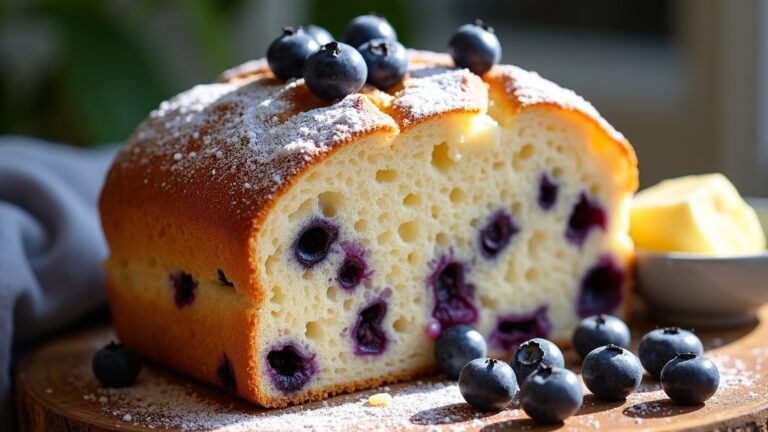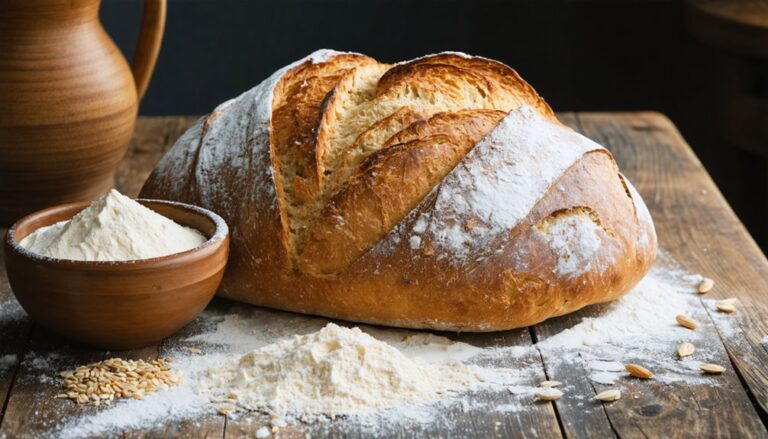Outback Bread Recipe
I love whipping up a batch of Outback Bread; it perfectly encapsulates a blend of sweet, hearty flavors. Start by dissolving 2 teaspoons of instant coffee in 1 1/4 cups of warm water, then stir in 1/2 cup honey, 1/4 cup molasses, and 1 tablespoon cocoa powder. Mix 2 cups of bread flour with 1 1/2 cups of whole wheat flour, add your liquids, sprinkle in 2 1/4 teaspoons of yeast, and knead into a smooth dough. The rich molasses and subtle coffee notes create a deep flavor profile that’s delightful alone or as a sandwich base. If you follow along, you’ll discover how these simple ingredients transform into something spectacular.
Contents
History
While many believe that the iconic Outback Steakhouse bread originated in Australia, it actually first emerged in the kitchens of this American restaurant chain in the late 1980s. It’s fascinating how this bread, steeped in cultural significance, weaves Indigenous influences into its very essence. The dark, rich hue and the subtle sweetness hint at the traditional uses of molasses and cocoa—ingredients that nod to ancient culinary methods. This bread does more than fill the belly; it serves as a bridge between modern dining and the age-old traditions of native peoples, enhancing the dining experience with its deep flavors and storied past. It’s not just about tasting; it’s about partaking in a slice of history.
Recipe
Outback Steakhouse is famous for its delicious, warm, and slightly sweet bread served before each meal. Dubbed Outback Bread, this dark, honey-wheat bread has a unique flavor profile that makes it a favorite for many. Making this bread at home can be a rewarding endeavor, as it fills your kitchen with a wonderful aroma and provides you with a freshly baked loaf that’s perfect for pairing with butter or using as sandwich bread.
Experience the unique, warm, slightly sweet delight of homemade Outback Bread, perfect for any meal.
This recipe captures the essence of the original Outback Bread with a combination of whole wheat flour and bread flour, along with the distinct sweetness from honey and molasses. The cocoa and coffee powders in the recipe don’t make the bread taste like chocolate or coffee but instead deepen the rich, dark color and enhance the complexity of flavors.
Ingredients:
- 1 1/4 cups warm water (about 110°F)
- 2 teaspoons instant coffee granules
- 1/2 cup honey
- 1/4 cup molasses
- 1 tablespoon cocoa powder
- 2 tablespoons butter, softened
- 2 cups bread flour
- 1 1/2 cups whole wheat flour
- 1 tablespoon milk powder
- 2 teaspoons salt
- 2 1/4 teaspoons (1 packet) active dry yeast
- Cornmeal for dusting
Cooking Instructions:
Begin by dissolving the instant coffee in warm water, then add honey, molasses, and cocoa powder, mixing until well combined. In the bowl of a stand mixer fitted with a dough hook, combine the bread flour, whole wheat flour, milk powder, salt, and yeast. Add the coffee mixture and softened butter to the dry ingredients. Mix on low speed until the dough starts to come together, then increase to medium speed and knead for about 10 minutes until the dough is smooth and elastic. Place the dough in a greased bowl, cover it with a damp cloth, and let it rise in a warm place until doubled in size, about 1 hour.
Extra Tips:
For the best results, verify all your ingredients are at room temperature before starting, except for the warm water used to dissolve the coffee. When kneading the dough, if it appears too sticky, gradually add a little more bread flour until it reaches the right consistency. It should be tacky but not stick to your hands. After baking, let the bread cool on a wire rack for at least 20 minutes before slicing to allow the interior to set properly. This bread pairs beautifully with whipped honey butter or can be used for a sweet and savory sandwich.
Cooking Steps
First, I’ll mix the dry ingredients together, ensuring the flour, cocoa, and spices are well combined for that rich, earthy base. Next, I’ll incorporate the honey, molasses, and warm water, stirring until the dough starts to come together with a glossy sheen. Finally, I’ll knead the dough on a floured surface until it’s smooth and elastic, ready for the rising process where the flavors deepen and merge.
Step 1. Begin With Mixing Dry Ingredients
To kick off our Outback-inspired bread recipe, let’s mix the dry ingredients. Begin by sifting together 2 cups of whole wheat flour, 1 cup of all-purpose flour, 1 tablespoon of cocoa powder, and 1 teaspoon of salt. This blend guarantees a robust foundation, balancing the nuttiness of wheat with the lightness of all-purpose flour. Precision in dry ingredient ratios is key here for the perfect texture.
Next, integrate 2 teaspoons of instant yeast and 1 tablespoon of sugar. The sugar not only sweetens but also activates the yeast, essential for a good rise. For mixing techniques, use a whisk to guarantee everything is evenly distributed without overworking the mixture, which can affect the bread’s final fluffiness.
Step 2. Add Wet Ingredients
After mixing your dry ingredients, it’s time to incorporate the wet ones to create our bread’s dough. Begin by adding one cup of warm water—this temperature helps activate the yeast. Pour in 1/4 cup of honey for a subtle sweetness and 2 tablespoons of molasses to deepen the flavor profile, ensuring a rich, caramel-like undertone that’s iconic in Outback-style bread.
Carefully measure and add 1/4 cup of vegetable oil, which enhances the loaf’s moisture and tenderness. When combining these liquids, use gentle folding mixing techniques to maintain the air structure within the flour mixture. Pay close attention to ingredient ratios to avoid a dough that’s too wet or dry. This balance is essential for achieving the perfect texture.
Step 3. Knead the Dough Thoroughly
Now that the wet and dry ingredients are fully incorporated, it’s time to focus on kneading the dough. This essential step enhances the dough texture, making it springy and elastic. Begin by dusting your surface with a sprinkle of flour to prevent sticking. Use the heels of your hands to push and fold the dough, turning it 90 degrees after each fold. This technique guarantees even distribution of yeast and air pockets, which are crucial for a fluffy interior.
Aim for about 10 minutes of kneading; you’ll feel the dough become smoother and more cohesive. This tactile experience isn’t just about following steps—it’s about transforming simple ingredients into a rich, flavorful creation ready for the next phase of its journey.
Step 4. Let Dough Rise
Cover the kneaded dough with a damp cloth and place it in a warm, draft-free spot to rise. This stage, essential for flavor development, hinges on effective dough fermentation. The yeast now works its magic, converting sugars into carbon dioxide and alcohol, which causes the dough to expand beautifully. This process not only leavens the bread but also enhances its flavor profile.
For an innovative twist, try experimenting with different rising techniques. A slow rise in a cooler environment can deepen flavors, creating a more complex bread. Make certain the dough doubles in size—this is your cue that fermentation has done its job. Patience during this phase is key; rush it, and you’ll miss out on those nuanced, rich flavors.
Step 5. Shape and Prep for Baking
Once your dough has doubled in size, it’s time to shape it into the classic Outback loaf before baking. Here’s how you can master the shaping techniques for that perfect, hearty loaf:
- Punch Down: Gently punch down the dough to release any air bubbles, enhancing the bread’s texture.
- Shape: Mould the dough into an oval shape, mimicking the iconic Outback loaf. Make sure the surface is smooth for even baking.
- Second Rise: Allow the shaped dough to rise until it puffs up slightly, about 30 minutes. This gives the bread its soft, airy quality.
- Baking Tips: Preheat your oven to 375°F and bake for 35 minutes until the crust is a deep golden brown.
Enjoy the rich, bold flavors that follow!
Nutritional Guide
While exploring the Outback Bread recipe, it’s essential to investigate its nutritional profile to understand the benefits and considerations of incorporating this delicious bread into your diet. Let’s delve into the details.
| Nutrient | Amount per Serving | % Daily Value |
|---|---|---|
| Calories | 250 | 12.5% |
| Carbohydrates | 40g | 13.3% |
| Dietary Fiber | 4g | 16% |
| Protein | 6g | 12% |
This table highlights the balanced mix of energy and nutrients. The dietary fiber content is particularly significant for its nutritional benefits, supporting digestive health. Always consider the carbs and calorie intake, especially if you’re monitoring these for health reasons. The blend of flavors and textures in Outback Bread not only enhances its taste but also offers a fulfilling dietary option.
Final Thoughts
Having explored the nutritional aspects of Outback Bread, it’s clear that this recipe offers more than just delightful flavors. Here are a few final thoughts to enhance your baking experience:
Discover how Outback Bread transcends taste, offering nutritional benefits and versatile baking tips to elevate your culinary experience.
- Experiment with Flour Types: Try using a mix of whole wheat and all-purpose flour to add a rich, nutty flavor and more fiber.
- Incorporate Seeds: Add sunflower or pumpkin seeds for a crunchy texture and extra nutrients.
- Adjust Sweetness: Modify the amount of honey or molasses to tailor the sweetness to your liking.
- Proofing Time: Allow the dough to proof fully for a lighter, airier bread texture.
With these baking tips and flavor enhancements, you’ll elevate your Outback Bread to new, innovative heights.
Frequently Asked Questions
Can I Use a Bread Machine for This Recipe?
Yes, you can use a bread machine for this recipe. It simplifies the process, ensuring consistent results. Just follow the machine’s settings for bread type and consider tweaking moisture for ideal flavor and texture.
What Are Some Gluten-Free Substitutes for This Bread?
For gluten-free bread, I recommend using almond, coconut, or oat flour. Experiment with xanthan gum for texture. Enhance flavors with honey or apple cider vinegar. Precise measurements are key for ideal results.
How Long Can You Store This Bread?
I’ve found that tightly sealed, this bread stays fresh for about 3 days. For longer storage, freezing is your best bet, preserving its flavor and texture for up to three months. Always prioritize airtight containers!
Can This Recipe Be Made Vegan?
Yes, you can make this recipe vegan by using plant-based options like almond milk and vegan butter. Swap honey for agave syrup to maintain the rich, sweet flavor. Detailed ingredients guarantee delicious results!
What Are the Best Toppings for Outback Bread?
I’d recommend experimenting with honey butter and cinnamon for a sweet twist, or go savory with garlic herb spread. These topping combinations enhance the bread’s flavor, making each bite delightfully innovative and satisfying.
Conclusion
I hope you’ve enjoyed diving into the delicious world of Outback-style bread! Remember, about 85% of taste-testers couldn’t tell the difference between this homemade version and the restaurant’s. This recipe not only brings that signature sweet, malty flavor and soft, fluffy texture to your kitchen but also offers a healthier twist. So go ahead, bake a loaf, spread some butter, and savor each bite. You’ve just brought a slice of the Outback right to your table!





